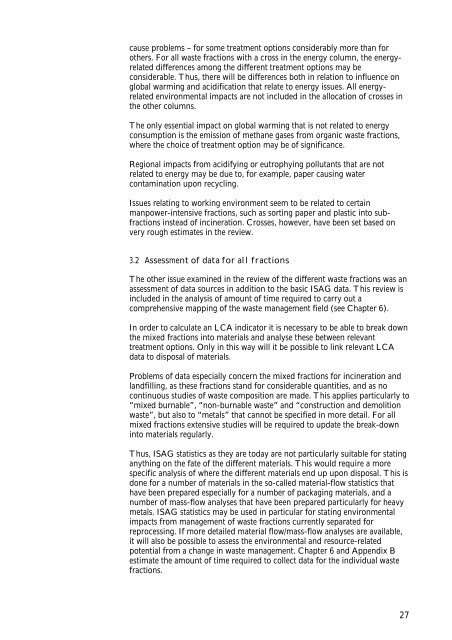Waste Indicators
Waste Indicators
Waste Indicators
Create successful ePaper yourself
Turn your PDF publications into a flip-book with our unique Google optimized e-Paper software.
cause problems – for some treatment options considerably more than forothers. For all waste fractions with a cross in the energy column, the energyrelateddifferences among the different treatment options may beconsiderable. Thus, there will be differences both in relation to influence onglobal warming and acidification that relate to energy issues. All energyrelatedenvironmental impacts are not included in the allocation of crosses inthe other columns.The only essential impact on global warming that is not related to energyconsumption is the emission of methane gases from organic waste fractions,where the choice of treatment option may be of significance.Regional impacts from acidifying or eutrophying pollutants that are notrelated to energy may be due to, for example, paper causing watercontamination upon recycling.Issues relating to working environment seem to be related to certainmanpower-intensive fractions, such as sorting paper and plastic into subfractionsinstead of incineration. Crosses, however, have been set based onvery rough estimates in the review.3.2 Assessment of data for all fractionsThe other issue examined in the review of the different waste fractions was anassessment of data sources in addition to the basic ISAG data. This review isincluded in the analysis of amount of time required to carry out acomprehensive mapping of the waste management field (see Chapter 6).In order to calculate an LCA indicator it is necessary to be able to break downthe mixed fractions into materials and analyse these between relevanttreatment options. Only in this way will it be possible to link relevant LCAdata to disposal of materials.Problems of data especially concern the mixed fractions for incineration andlandfilling, as these fractions stand for considerable quantities, and as nocontinuous studies of waste composition are made. This applies particularly to“mixed burnable”, “non-burnable waste” and “construction and demolitionwaste”, but also to “metals” that cannot be specified in more detail. For allmixed fractions extensive studies will be required to update the break-downinto materials regularly.Thus, ISAG statistics as they are today are not particularly suitable for statinganything on the fate of the different materials. This would require a morespecific analysis of where the different materials end up upon disposal. This isdone for a number of materials in the so-called material-flow statistics thathave been prepared especially for a number of packaging materials, and anumber of mass-flow analyses that have been prepared particularly for heavymetals. ISAG statistics may be used in particular for stating environmentalimpacts from management of waste fractions currently separated forreprocessing. If more detailed material flow/mass-flow analyses are available,it will also be possible to assess the environmental and resource-relatedpotential from a change in waste management. Chapter 6 and Appendix Bestimate the amount of time required to collect data for the individual wastefractions.27
















